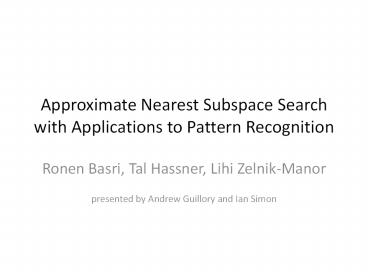Approximate Nearest Subspace Search with Applications to Pattern Recognition PowerPoint PPT Presentation
1 / 39
Title: Approximate Nearest Subspace Search with Applications to Pattern Recognition
1
Approximate Nearest Subspace Search with
Applications to Pattern Recognition
- Ronen Basri, Tal Hassner, Lihi Zelnik-Manor
- presented by Andrew Guillory and Ian Simon
2
The Problem
- Given n linear subspaces Si
3
The Problem
- Given n linear subspaces Si
- And a query point q
4
The Problem
- Given n linear subspaces Si
- And a query point q
- Find the subspace Si that minimizes dist(Si,q).
5
Why?
- object appearance variation subspace
- fast queries on object database
6
Why?
- object appearance variation subspace
- fast queries on object database
- Other reasons?
7
Approach
- Solve by reduction to nearest neighbor.
- point-to-point distances
8
Approach
- Solve by reduction to nearest neighbor.
- point-to-point distances
not actual reduction
9
Approach
- Solve by reduction to nearest neighbor.
- point-to-point distances
- In higher-dimensional space.
not actual reduction
10
Point-Subspace Distance
- Use squared distance.
11
Point-Subspace Distance
- Use squared distance.
12
Point-Subspace Distance
- Use squared distance.
- Squared point-subspace distancecan be
represented as a dot product.
13
The Reduction
- Let
- Remember
14
The Reduction
- Let
- Then
- Remember
15
The Reduction
16
The Reduction
constant over query
17
The Reduction
?
constant over query
18
The Reduction
?
constant over query
ZTZ I
19
The Reduction
?
constant over query
ZTZ I
Z is d-by-(d-k), columns orthonormal.
20
The Reduction
?
constant over query
ZTZ I
Z is d-by-(d-k), columns orthonormal.
21
The Reduction
- For query point q
22
The Reduction
- For query point q
- Can we decrease the additive constant?
23
Observation 1
- All data points lie on a hyperplane.
24
Observation 1
- All data points lie on a hyperplane.
- Let
- Now the hyperplane contains the origin.
25
Observation 2
- After hyperplane projection
- All data points lie on a hypersphere.
26
Observation 2
- After hyperplane projection
- All data points lie on a hypersphere.
- Let
- Now the query point lies on the hypersphere.
27
Observation 2
- After hyperplane projection
- All data points lie on a hypersphere.
- Let
- Now the query point lies on the hypersphere.
28
Reduction Geometry
- What is happening?
29
Reduction Geometry
- What is happening?
30
Finally
- Additive constant depends only on dimension of
points and subspaces. - This applies to linear subspaces, all of the same
dimension.
31
Extensions
- subspaces of different dimension
- lines and planes, e.g.
- Not all data points have the same norm.
- Add extra dimension to fix this.
32
Extensions
- subspaces of different dimension
- lines and planes, e.g.
- Not all data points have the same norm.
- Add extra dimension to fix this.
- affine subspaces
- Again, not all data pointshave the same norm.
33
Approximate Nearest Neighbor Search
- Find point x with distance
- d(x, q) lt (1 e) mini d(xi,q)
- Tree based approaches KD-trees, metric / ball
trees, cover trees - Locality sensitive hashing
- This paper uses multiple KD-Trees with
(different) random projections
34
KD-Trees
- Decompose space into axis aligned rectangles
Image from Dan Pelleg
35
Random Projections
- Multiply data with a random matrix X with X(i,j)
drawn from N(0,1) - Several different justifications
- Johnson-Lindenstrauss (data set that is small
compared to dimensionality) - Compressed Sensing (data set that is sparse in
some linear basis) - RP-Trees (data set that has small doubling
dimension)
36
Results
- Two goals
- show their method is fast
- show nearest subspace is useful
- Four experiments
- Synthetic Experiments
- Image Approximation
- Yale Faces
- Yale Patches
37
Image Reconstruction
38
Yale Faces
39
Questions / Issues
- Should random projections be applied before or
after the reduction? - Why does the effective distance error go down
with the ambient dimensionality? - The reduction tends to make query points far away
from the points in the database. Are there
better approximate nearest neighbor algorithms in
this case?

